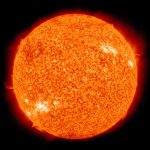The Impacts of Solar Explosions On Earth’s Magnetic Field
Otherwise known as CMEs, coronal mass ejections are a solar phenomenon where the sun’s outer layer (the corona), expels a large amount of devastatingly hot radiation and plasma into outer space. CMEs occur when the sun’s constant stream of plasma churns and twists around itself, leading to the formation of magnetic knots. As these magnetic knots develop, they build up massive amounts of energy, forcing them to break off and hurl into space, potentially toward earth. So, why don’t we typically notice such an event? If you remember back to our blog discussing the magnetic fields of our solar system, earth’s magnetic field protects our planet from harmful particles, similar to the concept of how an umbrella protects its user from rain. Earth’s magnetic field absorbs the blast of CMEs and other solar events and deflects the particles to the North and South poles, leading to brilliant aurora light displays.
If, however, a solar storm is large enough, the earth could experience devastating effects such as electricity and radio blackouts, or even the complete destruction of the power grid entirely. Although unlikely, similar events have occurred in the past, providing insight into what the future may hold. In 1859, The Carrington Event, otherwise known as the largest solar hurricane on record, hit the earth. However, the effects were minor with almost no modern technology at the time. Quebec was not as fortunate in 1989 when a geometric storm hit, resulting in the failure of their power grid. Most recently, in 2012, a solar hurricane as powerful as The Carrington Event narrowly missed earth to the relief of engineers everywhere.

